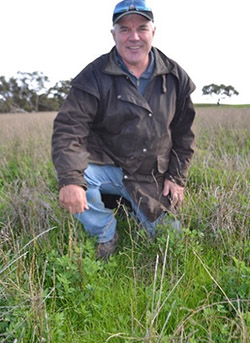Name:
Rodney and Paul Bartlett
Location:
‘Tolcairn’ Sherwood
Average Rainfall:
425mm
Enterprises:
2000 Merino ewes mated to Merino, 1600 Merino ewes mated to Dorset; Field Crops
Farm Area:
3640 ha
Significant changes to the weaning management program were undertaken by Paul Bartlett on ‘Tolcairn’ 15 years ago; and the change has paid dividends.
Traditionally lambs were weaned at approximately 20 weeks when the first lambs were ready to sell. Now Paul weans at 14 weeks from the start of lambing and has implemented various management strategies to ensure this is successful and profitable. Paul said “educating yourself and planning ahead are important if you are to implement a profitable weaning program”. They use a yearly calendar and weekly meetings with everyone involved in the farming business to ensure current practices are implemented in a timely manner and new ideas and concepts can be discussed and built into the yearly planner to be trialled.
“Developing yourself, being open to new ideas and trying new things which are tested, measured and reviewed is key for improving any aspects of the farm business including weaner management.”
Early weaning, planning, clean paddocks and quality pasture are essential to the success of Paul’s weaner management.
The decision to wean at 14 weeks from the start of lambing was implemented for a few reasons. “It allows ewes to recover for the next mating and milk is an expensive way to feed lambs,” he said. “After 8-10 weeks the lambs require very little milk from the ewe and starts to compete with the ewe for feed and that puts the lambs at risk.” To ensure all lambs are no younger than 8 weeks old to wean (at 14 weeks from the start of lambing) Paul lambs his ewes down over a 5-6 week period, with 85% of lambs born in the first 3 weeks. Teasers are used to stimulate oestrus in ewes to assist the tighter lambing period.
 Paul Bartlett in a pasture at Tolcairn
Paul Bartlett in a pasture at Tolcairn
Weaners are placed on high quality Lucerne based pasture with ad lib barley in self-feeders and also ad lib cereal hay. Paul says ‘the barley costs $4.50 per lamb in total and the nutritional benefits the barley brings to the Lucerne based system in weight gain far outweighs the cost’.
The energy content of barley helps to balance the high protein content of the Lucerne based pasture. Lambs are imprint fed prior to weaning with ewes and lambs fed 3 times per week for four weeks depending on the pasture availability and quality. Prior to weaning all ewes and lambs are placed in a holding paddock the day before and fed ad lib hay to ensure the lambs are not hungry when being placed on the Lucerne. Paul encounters very few deaths of weaners.
The high quality feed in the weaning system means vaccination is an essential part of Paul’s management particularly pulpy kidney. Lambs are vaccinated at marking with a 6 in 1 and again at weaning with the addition of Vitamin B12. Ewes are given their annual booster two weeks prior to lambing which provides some passive immunity to the lamb. He adds “we don’t have any issues with bringing ewes into the yards so close to lambing as they are in condition score 3-3.5 and we walk them in slowly.”
Pasture paddocks for weaning are destocked over summer by making use of stubbles. “We aim to have our weaning paddocks destocked for 4-5 months before we put our weaners on them.”
Weaning at 14 weeks from the start of lambing and good management techniques has resulted in lambs being turned off quicker at targeted market specifications at higher prices, before the flush of new seasons lambs hit the market.
He has minimal deaths and lambs are turned off before grass seeds become a problem. Merino replacements and any Merino wethers that are carried through are managed carefully for grass seeds with the use of forage and cereal crops combined with strategic herbicide application. Paul is currently trialing the most effective strategy.
During dry seasons Paul will wean earlier than 14 weeks, sell the lambs, cull dry ewes and use the opportunity to class and cull ewes. Paul also uses confinement feeding as a strategy, which has helped him maintain ground cover throughout dry years.
Moving forward Paul plans to trial yard weaning to determine if it becomes part of their weaning practice. The current system uses paddock weaning but incorporates electric fencing to ensure lambs remain contained and learn to respect fences. Paul says “for electric fencing to work well for weaners it must be working. Testing 2-3 times a week when checking troughs or feeders is an ideal time to do this”.
Prepared by Tiffany Bennett, Primary Industries and Regions SA: Rural Solutions SA (2018).